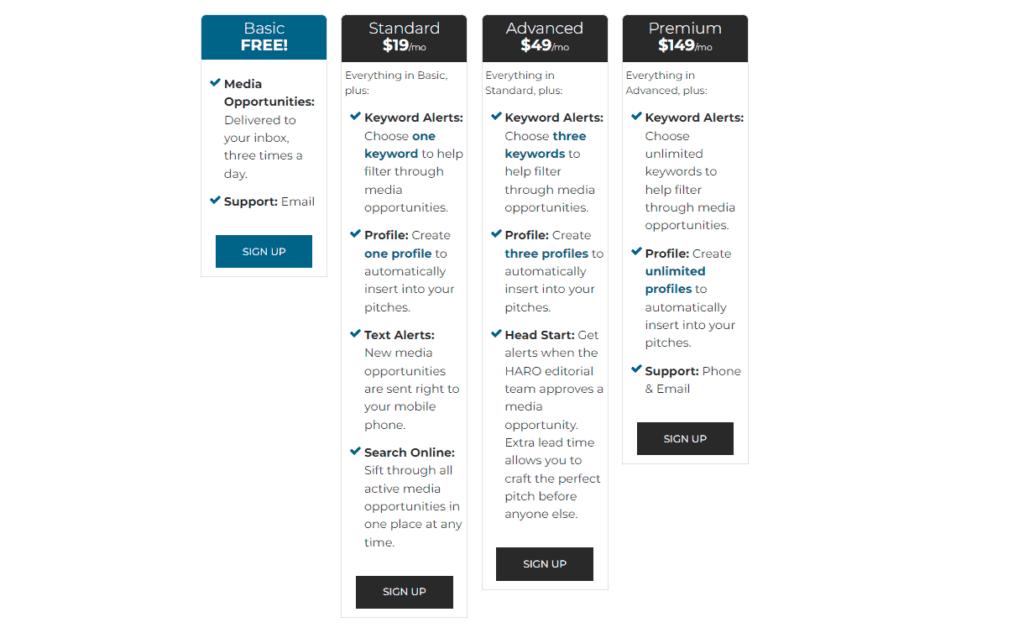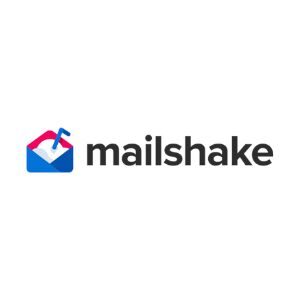-
Link Outreach & PR
-
Help a Reporter Out is an online service for journalists to obtain feedback from the public. It enables journalists to connect with experts in issues relevant to their reporting.
-
https://www.helpareporter.com/
Do you need help promoting your business?
Are you looking for a way to get more media coverage?
HARO may be the tool for you.
HARO is a service that connects journalists with sources for stories.
Sources can then provide quotes or information to reporters who are working on articles.
It’s a legitimate way to get your business in the news and build backlinks to your website.
In this article, we will discuss HARO in detail and explain how it can benefit you.
HARO at a Glance
Here are the basic HARO plans to choose from, along with who the platform works best for.
- Market Segment: Media coverage
- Best For: Reporters and content creators.
- Plans & Pricing:
- Basic: Free
- Standard: $19 per month
- Advanced: $49 per month
- Premium: $149 per month
What Is HARO?
HARO, or Help a Reporter Out, is a tool that connects reporters and knowledgeable sources.
The following media outlets use HARO.
- Chicago Tribune
- TIME
- Fox News
- Reuters
- Wall Street Journal
- New York Times
- ABC
- Refinery 29
- Mashable
What Is HARO Used For?
HARO exists to help with media coverage and backlinking.
Journalists from major news outlets need you to provide content for stories.
In exchange, you will get extra business exposure.
Your website will receive backlinks from credible sites.
How HARO Works
HARO works by connecting journalists, PR professionals, bloggers, content marketers, and reporters with a database of potential sources for stories or articles.
Three times per day, HARO sends out an email blast to its subscribers with a list of recent queries from reporters.
Each email includes the name of the publication, the deadline, and a brief description of what they’re looking for.
If you’re a HARO subscriber and think you have something that could fit, you can respond to the email with your pitch.
Notable Features of HARO
The Help a Reporter Out platform provides plenty of features to make the process run smoothly.
1. A User-friendly Interface
There’s nothing difficult about using and navigating HARO’s dashboard.
Journalists can quickly find the sources they need.
You can send pitches with just a few clicks.
Additionally, HARO offers a mobile app to make pitching on the go even easier.
2. A Wide Range of Topics Covered
HARO covers a wide range of topics, including business, entertainment, health, lifestyle, news, politics, science, technology, and more.
You’re sure to find a reporter looking for sources on a topic that interests you.
3. An Extensive Database of Potential Sources
The platform boasts an extensive database of potential sources.
With almost one million sources, HARO can connect a journalist with the right source for a story.
Also, the database has over 75,000 bloggers and reporters looking for stories.
If you’re a source, you’ll see plenty of daily opportunities.
4. Timely Email Alerts
HARO sends out three email blasts per day.
You can also set up alerts for specific topics.
5. Search for Specific Topics
HARO’s search function allows you to quickly find the pitches that fit you and your expertise.
6. Filter Sources by Location
The Help a Report Out filter function allows you to find sources in specific locations.
It is especially useful for reporters working on a local story and local businesses looking for localized exposure.
7. Pitch to Multiple Reporters at Once
HARO’s pitch function allows you to pitch to multiple reporters at once.
It saves you time by allowing you to send one pitch to multiple reporters.
8. Customer Support
You can contact HARO’s customer support team by email on the free plan and the first two paid plans.
With the Premium plan, you can use phone support as well.
Are There Any Minimum Requirements Necessary to Use HARO?
No, you only need Internet access and an email account to use the service.
How Much Does HARO Cost?
We mentioned plans and pricing above.
Let’s now look at each plan in detail.

Basic Plan
With the Basic plan, you will receive three daily email blasts.
If you get stuck or don’t understand anything, you can contact HARO’s customer support staff for help.
It will take time to get used to sifting through offers that don’t fit your knowledge base.
With practice, you’ll start navigating the process quickly each morning and afternoon.
Cost: $0
Standard Plan
The standard plan gives you everything from the Basic plan.
One added feature helps you become more efficient.
You can now include keyword alerts inside your HARO profile.
Using these alerts, HARO will send you a daily email with every query that includes your selected keyword.
It can help you quickly find the queries most relevant to your needs.
Other helpful features opened inside the Standard plan include the following.
- Text alerts: Use the app to get media opportunities sent to your mobile phone
- Profile: HARO lets you set up one profile and automatically include it inside each pitch
- Online search: Use this feature to search through the active media opportunities
Cost: $19 per month
Advanced Plan
The HARO Advanced plan works well for those who want to get the most out of their HARO experience.
With this plan, you receive everything from the Standard plan plus a few added features.
First, you can now include three profiles inside your HARO account.
Use this extra benefit if you have multiple businesses or expertise in different areas.
Second, you’ll see reporter requests before others in the network.
It gives you extra time to craft pitches before all the Basic and Standard users get involved.
HARO calls this the “Head Start” feature.
The editorial team sends you an immediate alert after approving each reporter’s request.
Third, HARO lets you use three keywords now as you filter through all available media opportunities.
Cost: $49 per month
Premium Plan
The HARO Premium plan is ideal for agencies, public relations firms, or any company that sends out multiple pitches on behalf of clients.
HARO’s premium account gives you everything from the Advanced plan plus a few other agency-specific benefits.
With this plan, you can now add an unlimited number of profiles to your HARO account.
You also get an unlimited number of keywords you can use to filter through media opportunities.
You’ll continue to see “Head Start” requests and have extra time to put pitches together.
The Premium plan boosts the HARO customer support experience.
Instead of email support only, this plan opens up phone support.
Cost: $149 per month
Does HARO Have an Enterprise Version Available?
No, HARO does not have an enterprise version available.
HARO only has the four different plans we explained above: Basic, Standard, Advanced, and Premium.
The best option for enterprises is the Premium plan since it offers unlimited access to profiles and keywords.
HARO Promotions & Savings
Let’s discuss whether HARO offers promotional savings on its plans.
Does HARO Have a Free Trial?
Yes, the free Basic plan essentially gives you a forever-free option.
You aren’t required to upgrade to a paid plan.
Does HARO Offer Coupon Codes?
No, HARO does not offer any type of coupon code or discount for its plans.
Does HARO Have a Lifetime Deal?
You must choose from one of the plans listed above.
HARO doesn’t have a lifetime deal.
Who Are HARO’s Main Alternatives?
Three main HARO alternatives exist for you to consider.
They include Qwoted, Terkel, and ProfNet.
1. Qwoted
Qwoted is a HARO-like service that connects you with journalists and reporters who need sources for their stories.
You can use Qwoted to get quoted in the press, connect with new customers, and grow your business.
Large media outlets use Qwoted.
For example, you can potentially get mentioned in Huffington Post, Forbes, UCLA Health, the New York Times, and Reuters.
Unlike HARO, Qwoted notifies you when a reporter reads your pitch, helping you to better understand whether your requests get noticed.
2. Terkel
Terkel is another platform that allows journalists to post requests for sources and for people to respond to them.
It’s a bit different from HARO in that it focuses more on connecting individuals with Terkel’s partner websites.
You won’t reach the media giants listed on the HARO platform.
However, getting published on a partner site of Terkel still works well for media attention and backlinks.
Three partners include SCORE, Keap, and the University of Arizona.
The main difference between HARO and Terkel is that HARO partners focus on getting quick blurbs from its members.
Terkel puts out entire articles that may feature your expertise.
3. ProfNet
ProfNet is a part of Cision, which is a large media intelligence platform.
Cison owns HARO, too.
Unlike HARO, ProfNet focuses more on public relations professionals.
HARO gets you featured in stories and articles.
ProfNet places you inside featured press releases.
How Does HARO Differentiate Itself From Competitors?
HARO has several features that make it unique from its competitors.
First, HARO connects you with opportunities for top-tier publications to feature you.
Second, HARO allows you to submit pitches directly to reporters.
It means that you don’t have to go through a middleman or an agent to get your work featured.
Lastly, HARO lets you use its free service for as long as you please.
It makes it an attractive option for small businesses and individuals who may not have the budget for paid media tools.
Who Is HARO Best For?
HARO is best for businesses, entrepreneurs, and public figures who need more media coverage and backlinks.
Why Is HARO Best For Entrepreneurs and Businesses?
While individuals seeking press for their personal brand or blog can use HARO, the tool can benefit businesses the most.
It is because HARO provides access to a much wider range of media outlets and reporters than other similar tools.
Is HARO Easy To Use?
HARO provides a user-friendly interface.
Its features are straightforward.
You shouldn’t run into any trouble while setting up your account and using the platform.
What Features Do Some Users Love?
For the most part, most HARO users love two main features.
The first is the ability to receive keyword alerts.
Using this feature makes it easier to find relevant HARO queries.
The second is the profile creation feature.
It saves time when you can automatically place a pre-written profile into each pitch you send out.
What Features Do Some Users Find Frustrating?
One negative feature of HARO affects one of the parties getting connected through the platform.
The second frustrating feature affects the other party involved.
Reporters become frustrated sometimes because they get too many replies from unqualified sources.
As HARO became popular, more people hopped on the platform only to secure backlinks.
Journalists will get answers to their queries from marketers who can’t provide adequate content for stories.
The reporters using HARO will eventually find perfect matches for their needs.
However, it can take longer depending on the topic and how many unqualified marketers attempt to secure a backlink without providing a solid response.
When using the HARO platform as a business looking for backlinks and media exposure, you’ll run into questionable queries.
You’ll see plenty of requests from anonymous sources.
It’s better to skip those queries in favor of reporters who tell you about themselves upfront.
Dealing with anonymous sources who end up putting your name on questionable sites becomes frustrating.
It could even hamper your reputation.
Frequently Asked Questions
If you still have questions about HARO, let’s answer two commonly asked questions about the platform.
Is HARO good for SEO?
Yes, HARO is excellent for SEO.
Any time you get your name or brand in the press, it’s good for search engine optimization.
Google will notice that your website attracts reputable backlinks.
In turn, you can improve traffic numbers through this SEO technique.
What is the best way to use HARO?
Use HARO strategically.
Create a HARO profile that sells your qualifications.
Pitch credible reporters who will likely want your story.
Remain patient, too.
It can take time for the right reporter to accept your pitch.
Wrapping Up
HARO is a beneficial service for both reporters and sources.
It allows reporters to quickly find sources for their stories.
As well, HARO allows sources to get featured in major publications.
HARO’s best features include its simple interface, the ability to track responses, and its wide range of categories.
Are you ready to give HARO a try?
We recommend signing up today.
After using HARO, please come back to leave a review in the comments below.






